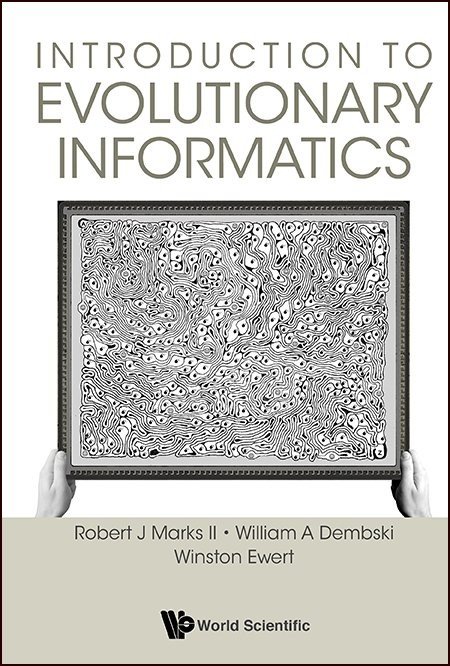Can Wholly Random Processes Produce Information?
Can information result, without intention, from a series of accidents? Some have tried it with computers…In Define information before you talk about it, neurosurgeon Michael Egnor interviewed engineering prof Robert J. Marks on the way information, not matter, shapes our world (October 28, 2021). In the first portion, Egnor and Marks discussed questions like: Why do two identical snowflakes seem more meaningful than one snowflake. Then they turned to the relationship between information and creativity. Is creativity a function of more information? Or is there more to it? And human intervention make any difference? Does Mount Rushmore have no more information than Mount Fuji? Does human intervention make a measurable difference? That’s specified complexity. Putting the idea of specified complexity to work, how do we measure meaningful information? How do we know Lincoln contained more information than his bust?
On a hot button topic, last time out, they addressed the hope that advanced AI could somehow recognize and filter out bias and hate — the problem is that bias is innate in programming, according to the No Free Lunch Theorem. Dr. Marks then talks about his work in evolutionary computing, raising the question, can random processes generate meaningful information? Or is intelligence required?
This portion begins at 54:01 min. A partial transcript and notes, Show Notes, and Additional Resources follow.
Michael Egnor: Many evolutionary biologists claim that all of the information present in living things got there by natural selection of randomly assorted variation. Is that true? It’s very clear that living things contain a lot of information. Is it possible for the Darwinian process of random heritable mutation and natural selection to generate all that information in biology or even any of it?

Robert J. Marks: My background is not in biology but in computer science and computer engineering. And one of the things we do is artificial intelligence. And I think maybe your question — translated to artificial intelligence — is: Can anything happen in artificial intelligence from totally random, unguided mutations and processes? And the answer is absolutely not. We did a lot of work.
Winston Ewert and design theorist William Dembski did a lot of work analyzing programs that were purported to generate information.
With the advent of the computer, people said, evolution is such a slow process. It’s going to take us years and years in the laboratory to do anything. But if we have a computer, we can take these Darwin algorithms, simulate them on a computer, and show that indeed it works. And so people tried that. And there were people jumping up and down and saying, “Yes, we have proven Darwinian evolution.”
There was a problem, though, with their simulations. Number one is that all of the simulations were guided to be successful … You have the three steps of evolution: random mutation, killing off the weak, and the survival of the fittest.
The key step in those three steps is survival of the fittest. How do you determine what the survival of the fittest is? In order to do that, you have to have something called a fitness function or an objective function.
That needs to be imposed by the programmer. The programmer is telling you how the organism can better itself. That is necessary in order to perform evolution on the computer. In our book, Introduction to Evolutionary Informatics, And let me say it again, Introduction to Evolutionary Informatics, we looked at a number of computer programs that purported to perform Darwinian evolution… based on publications in prestigious journals and conferences.
We showed that in all cases, that yes, [design] was required, and that there’s mathematics behind it. The mathematics is based on the No Free Lunch Theorem, which was popularized in the IEEE transactions on evolutionary computing in 1997. There, David Wolpert and W. G. Macready showed something which astonished the area of genetic programming and evolutionary programming.

Their conclusion — and their mathematical proof — was: If you have no idea about the direction that you’re going, you’re never going to get there. In accomplishing a goal, one search algorithm is as good on average as another one. And this astonished the computer science field, especially those in evolutionary computing. But it caught on. We took this up, and it’s covered in the Evolutionary Informatics book, for example.
We showed that, not only was this true, but we could measure the degree to which people infused information into the search process. We could measure in bits, the amount of information that a search process the programmer put into a computer program in order to get it to succeed…
And one of them that we took on, the biggest one (because it was part of the Dover trial), was a program called Avida, A-V-I-D-A. And Avida purported to perform evolutionary algorithms. But it was chock full of added information. Now the metric that we derived in order to measure the degree of information put into a algorithm in order for it to succeed is something called active information. This can be measured in bits. We were able to measure the amount of active information put into Avida and it was a lot.
We also took on another algorithm called EV, which purported to show Darwinian evolution and showed it was chock full of active information. I don’t think the people that wrote the program did this intentionally and tried to hide it. I think rather, they were numbed by familiarity.
Michael Egnor: It seems to me from what you’re describing that the idea that there’s information put into these programs is pretty obvious. It’s fascinating that you can measure it, that you quantify it. These programs are all elegant computational tools. And of course, there’s information being put in. How could experts like these Darwinists not see that? I mean that’s really blind. That’s quite amazing.
Robert J. Marks: I have this old theory of the difference between scientists and engineers. I’m an engineer. Scientists often come up with good theories. And they like these theories, and they’re vetted, and they’re placed up on a throne. And they’re kind of worshiped like a queen and protected like a queen. Whereas engineers make the Queen come down from the throne and scrub the floor. And if she doesn’t scrub the floor, we fire her.
And I think that that’s probably the case here. Now, why did these people do this? People might have heard about this before, but I call it the Dead Man syndrome. It illustrates the challenges of being in a silo of belief, a silo of ideology that you can’t see out of.
A man enters a psychiatrist’s office and says, “Doc…” He was really sad. “Doc, I’m dead.” And he started sobbing, he sat down and put his head down and started to cry.
The psychiatrist was just astonished. He said, “Well, come on, you’re not dead, you’re walking, you’re talking. And dead people don’t do that.”
The guy says, “Yeah, I know. It’s astonishing, isn’t it that I can walk and talk. But doc, I’m dead.”
So the psychiatrist thought of a way that he could convince the man that he wasn’t dead. So he had a diabetic finger prick thing and he asked the guy, “Do dead men bleed?”
And the patient said, “Why no, dead men don’t bleed.”
He said, “Here, give me your finger.”
So he pricked his finger and the guy started to bleed, a little puddle of red blood came up, and the guy’s eyes got big. And he looked at the doctor and looked at the puddle, looked at the doctor again and said, “Doc, this is incredible. You’re right, and I’m wrong. Dead men do bleed.”
The point of that story is, if you’re so ensconced in an ideology, you are going to be pounding square pegs into round holes in order to defend that silo of ideology. And I think we point a finger at a Darwinists for doing that. But I think everybody has to be concerned about placing themselves in a silo of belief and allow themselves to be open to other explanations, and go where the evidence leads us.
I mean, this is what the scientists say: Go where the evidence leads us. And the evidence in terms of Darwinian evolution is especially as implemented and simulated by a computer, is that no, it simply doesn’t work, not unless it’s guided, not unless there’s a teleological forcing function there. You have to figure out what is good, you have to figure out what that survival of the fittest is. And that is typically a place where active information is placed into the algorithm. And yes, it can be measured in bits, in many cases. And that’s pretty good. And I think we’re very proud of being able to do that.

Michael Egnor: I was myself sort of raised in a Darwinist atmosphere. And I believed it. I really believed that Darwin explained how living things came to have adaptations. I thought Darwin explained how man came to be. And it was really the intelligent design movement that helped me to see how wrong that is, What nonsense that is.
And frankly, every time I look at this issue, it leaves me flabbergasted that Darwinists could really believe the stuff they believe. And they really are in a silo. But goodness gracious, the silo has very thick, strong walls. These people can’t get themselves out of it.
You mentioned that, certainly the goals to which evolutionary change tend have to be specified. That you don’t get anywhere unless you specify goals.
Michael Egnor: But even randomness requires information and intelligence. Because there’s an old Aristotelian adage that chance or accidents only occur as conjunctions of designed things. That is, they’re conjunctions that you didn’t intend but they depend upon a milieu of design to happen. If you didn’t have the milieu of design, the randomness wouldn’t even have any meaning.
A good example is a car accident. So you’re going through an intersection and some other guy goes through the intersection, and you collide. Well, that’s an accident. Nobody intended the collision. But everything else in that event is designed. The automobiles you’re driving are designed. Both you and the other guy were intending to go somewhere. The stoplight that one person ignored was designed. The road was designed. So randomness has to happen on a framework of design. So design even shows up in randomness, as well as goals, purposes.
Next: How even randomness shows evidence of design
Here are all the episodes in the series. Browse and enjoy:
- How information becomes everything, including life. Without the information that holds us together, we would just be dust floating around the room. As computer engineer Robert J. Marks explains, our DNA is fundamentally digital, not analog, in how it keeps us being what we are.
- Does creativity just mean Bigger Data? Or something else? Michael Egnor and Robert J. Marks look at claims that artificial intelligence can somehow be taught to be creative. The problem with getting AI to understand causation, as opposed to correlation, has led to many spurious correlations in data driven papers.
- Does Mt Rushmore contain no more information than Mt Fuji? That is, does intelligent intervention increase information? Is that intervention detectable by science methods? With 2 DVDs of the same storage capacity — one random noise and the other a film (BraveHeart, for example), how do we detect a difference?
- How do we know Lincoln contained more information than his bust? Life forms strive to be more of what they are. Grains of sand don’t. You need more information to strive than to just exist. Even bacteria, not intelligent in the sense we usually think of, strive. Grains of sand, the same size as bacteria, don’t. Life entails much more information.
- Why AI can’t really filter out “hate news.” As Robert J. Marks explains, the No Free Lunch theorem establishes that computer programs without bias are like ice cubes without cold. Marks and Egnor review worrying developments from large data harvesting algorithms — unexplainable, unknowable, and unaccountable — with underestimated risks.
- Can wholly random processes produce information? Can information result, without intention, from a series of accidents? Some have tried it with computers… Dr. Marks: We could measure in bits the amount of information that the programmer put into a computer program to get a (random) search process to succeed.
- How even random numbers show evidence of design Random number generators are actually pseudo-random number generators because they depend on designed algorithms. The only true randomness, Robert J. Marks explains, is quantum collapse. Claims for randomness in, say, evolution don’t withstand information theory scrutiny.
Show Notes
- 00:00:09 | Introducing Dr. Robert J. Marks
- 00:01:02 | What is information?
- 00:06:42 | Exact representations of data
- 00:08:22 | A system with minimal information
- 00:09:31 | Information in nature
- 00:10:46 | Comparing biological information and information in non-living things
- 00:11:32 | Creation of information
- 00:12:53 | Will artificial intelligence ever be creative?
- 00:17:40 | Correlation vs. causation
- 00:24:22 | Mount Rushmore vs. Mount Fuji
- 00:26:32 | Specified complexity
- 00:29:49 | How does a statue of Abraham Lincoln differ from Abraham Lincoln himself?
- 00:37:21 | Achieving goals
- 00:38:26 | Robots improving themselves
- 00:43:13 | Bias and concealment in artificial intelligence
- 00:44:42 | Mimetic contagion
- 00:50:14 | Dangers of artificial intelligence
- 00:54:01| The role of information in AI evolutionary computing
- 01:00:15| The Dead Man Syndrome
- 01:02:46 | Randomness requires information and intelligence
- 01:08:58 | Scientific critics of Intelligent Design
- 01:09:40 | The controversy between Darwinian theory and ID theory
- 01:15:07 | The Anthropic Principle
Additional Resources
- Robert J. Marks at Discovery.org
- Michael Egnor at Discovery.org
- Claude Shannon at Encyclopædia Britannica
- Andrey Kolmogorov at Wikipedia
- Spurious Correlations website
- Chapter 7 of: R.J. Marks II, W.A. Dembski, W. Ewert, Introduction to Evolutionary Informatics, (World Scientific, Singapore, 2017).
- Winston Ewert, William A. Dembski and Robert J. Marks II “Algorithmic Specified Complexity in the Game of Life,” IEEE Transactions on Systems, Man and Cybernetics: Systems, Volume 45, Issue 4, April 2015, pp. 584-594.
- Winston Ewert, William A. Dembski and Robert J. Marks II “On the Improbability of Algorithmically Specified Complexity,” Proceedings of the 2013 IEEE 45th Southeastern Symposium on Systems Theory (SSST), March 11, 2013, pp. 68-70
- Winston Ewert, William A. Dembski, Robert J. Marks II “Measuring meaningful information in images: algorithmic specified complexity,” IET Computer Vision, 2015, Vol. 9, #6, pp. 884-894
